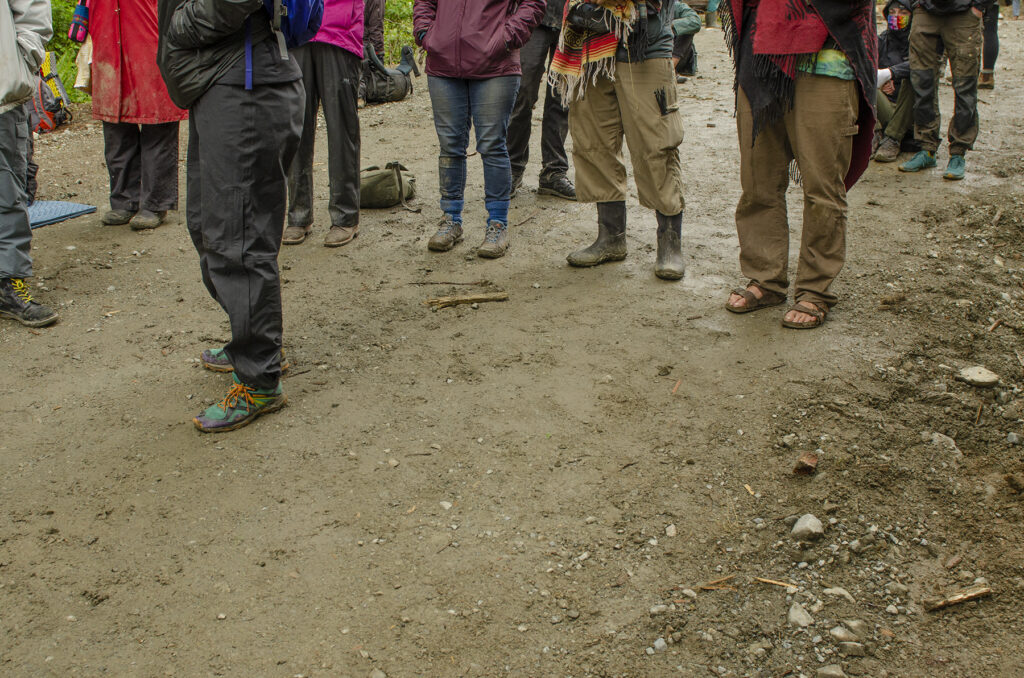
In the beginning, there were twenty.
On August 9th, 2020, twenty people connected by the desire to stop what should not be happening met at Lizard Lake, a recreational area on Southern Vancouver Island. Lizard Lake. A seemingly arbitrary place to meet, except for the fact that it’s near Fairy Creek, one of the last of the pristine old growth forest watersheds in the world, a mixed forest where Mother Trees support saplings and seedlings, the lives of these often over 1000-year-old trees that, as forest ecologist Suzanne Simard tells us, far eclipse colonialism.[1] With coastal old growth forests absorbing about seven tonnes of carbon dioxide per hectare per year[2], the 1,189 hectares that comprise the Fairy Creek Watershed absorb 8,323 tonnes of carbon every year;[3] Fairy Creek is a community united with mycorrhizal, underground fungal networks that connect and communicate between the Mother Trees that are alive with the reality that everything is connected, including us, the humans, who devastate the earth for monetary profit and, in so doing, devastate ourselves. Who kill our Great Mother.
Tourist brochures tell is how there are a lot of trails around Lizard Lake to get you out for a stroll. There is lots of wildlife to view, and you can see many kinds of birds there. Every year, Lizard Lake is stocked with rainbow trout and is a popular recreational fishing destination because the fish are plentiful and can reach 35 to 45 cm in length.
“Make sure not to pollute the lake,” a sign says. “The trout sure are big this year!” —even though there are no natural fish in the lake as participants in a healthy ecosystem anymore due to the extensive logging in the 20th Century when the inlets and outlets were choked by debris and any thought of healing or cleaning up was deemed impractical—too much work to confront and deal with the truth.[4] There is no sign announcing the intact ecosystems that are being threatened a few kilometres away: up in the mountains inscribed by logging roads that snake their way towards the biggest trees that can still be saved. We are living in what Elder Bill Jones calls the world of let’s pretend, where direct action is the only way we can awaken from the Great Sleep.
*
They had to do something, right away,
the first Forest Defenders of the Fairy Creek Blockades agreed, greeting in the Lizard Lake parking lot, some connected for years through other environmental action, others meeting for the first time. They decided to go into the forest and have a circle, a circle that would become a tradition at the Fairy Creek Blockades where people come together to listen and discuss. They introduced each other. One Forest Defender remembers how:
“It was really inspiring. I remember that just having all these people around who were all feeling the same way about it. We have to stop this. This is insane and we gotta do something about it.”
There was no more time to wait. It was Sunday and industry is always right on time Monday morning. And so, twelve of the twenty decided to drive up, behind the exquisitely drawn curtain that conceals the clear cuts and ecological destruction, into reality. First step: conquer the logging road, Reid Main.
There is no predictability to logging roads as they wind precariously in rabid search of the biggest trees. There is no predictability unless one is referring to the predictability of greed, what generates the madness that snakes up and around mountains, through the open wounds of the clear-cuts, deadlands of debris and bleached-out stumps, through unprofitable stands of trees. The machinery blasts and grinds, violates our Great Mother, metal beasts held together by bolts tightened by denial, hard snouts salivating over the biggest ones, the giants, the mother trees whose thousands of years of connection to the rest of the forest are reduced to dollars and the satiation of the insatiability of greed. Elder Bill tells us how greed is an expression of deviant selfishness and becomes the guiding light in your life. Greed, always after more of the same, gouges these mad, frantic flurries of roads into the mountainsides, and it was this deviant light that the Forest Defenders had no choice but to follow that night. A predatory light. At its mercy to stop what will happen if they don’t.
“We had to find the way,” some of the first Forest Defenders recall.[5] “The edges of the road were so steep you couldn’t see around them. You could just drive over the edge on the other side because you couldn’t see where the edge was. What you were driving into … or off. You could just drive off. Like the most logical thing that would happen. Just drive off. The road was so narrow, so steep, the edges so vicarious, loose sharp rocks, the pointed shards of recent blasting, wheels spinning. Can I turn sharply enough into what I cannot see? Your fingers are crossed. Knuckles beyond blue. Survive going around the corners. Survive. The corners. You climb-climb-climb. It was getting darker and darker. Steep and sketchy logging road. Climb-climb-climb. At one point I gave up. Steep and sketchy logging road, twisted by the edges of continued colonialism, like a mass of metal that has been clenched into a fist, ready to reach out, snap and spew its imperial infrastructure whenever the opportunity for exploitation arises.”
Greed is colonialism. Colonialism is greed, and capitalism and colonialism are one and the same, Elder Bill says. And one cannot help but think of the extent industry goes to getting to the last of the big trees, machinery climbing and clinging to the same precarious road. What greed will do to fail in satiating itself.
“We arrived close to midnight.”
*
What must they have looked like, united around the fire that night, camping chairs and tents nestled amidst the machinery driven by humans believing they are just doing their job, doing what they have been told to do in what Elder Bill describes as a civilization that is a system of denial governed by greed and creating a world of let’s pretend?
What must they have looked like snug in the orange glow of their fire, necessary even in August at such a high elevation, its warmth exposing the long arm of the Crawler Excavator at rest, ready to gouge and grab in the morning, accompanied by its dozing partner, the Rock Drill, with its foreboding track pads of carbon black and silica, brooding in the dark? Not missing a moment of summertime daylight, the keys of industry are turned at 5 am; snorts and blasts of diesel begin the duet of squeak and crunch as the machinery enacts the mythology of progress as take, continuing where they had left off on Friday afternoon. They wobble and creak over their bereft earth, dumb machines given the power to destroy ecosystems.
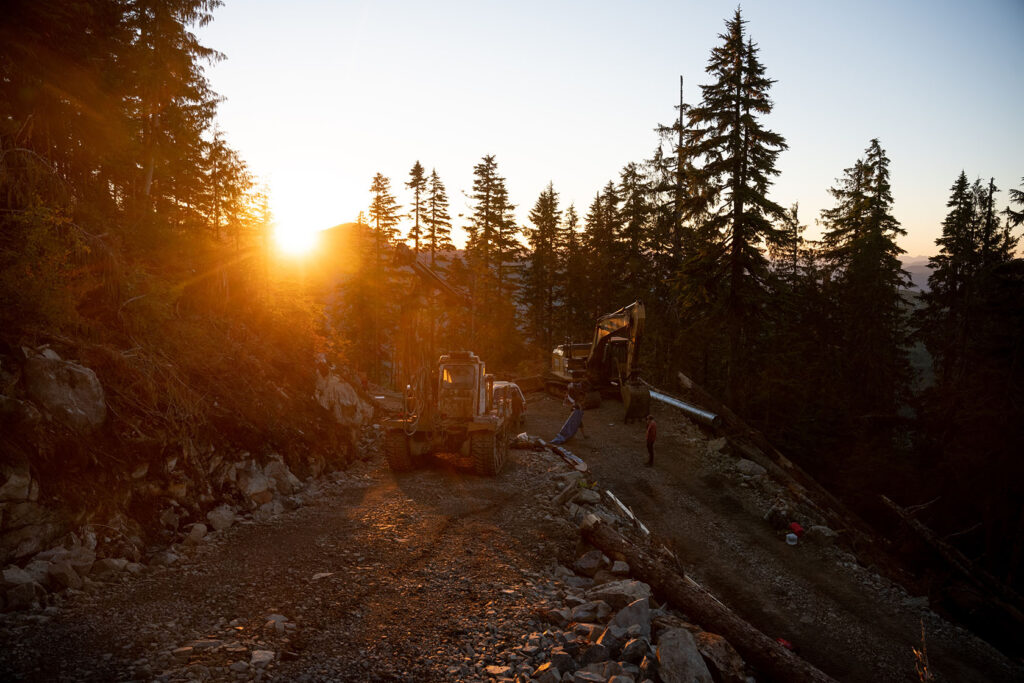
The Forest Defenders have arrived just in time. This particular logging road is headed for Titania, an estimated 1000-year-old[6] Western Yellow Cedar and the gateway to the pristine forest of the Fairy Creek Watershed. This ancient tree’s age doubles the longevity of her name that originated with Shakespeare’s Titania, Queen of the Fairies, in A Midsummer Night’s Dream and, in keeping with the name of the pristine watershed the ancient tree Titania guards, this makes perfect sense when one immerses themselves within the wonderland of the old growth forest. There is no make-believe here, unlike Lizard Lake and its manufactured fish and manicured trails. As we are intoxicated by the purest, oxygen-rich air, as we marvel at mosses that virtually blind with their green brilliance, as we are dazzled by the chimes of golden tanagers, there is no doubt. We are transported away from the colonial world of denial and let’s pretend to where we really are, where we have always been—we are enchanted by where we can find ourselves again.
But Titania doesn’t stop there. She touches upon another, mythological namesake: the Greek Goddess Artemis, the patroness of nature, wildlife, and childbirth. Like all mother trees, Titania is an ecosystem unto herself birthing and supporting countless other creatures. One cannot imagine how deeply and widely her roots extend, intertwining with those of all the other trees who have been embraced over the centuries by her reach; one cannot crane their neck back far enough to fully absorb the extent to which she reaches her canopy into the sky. Humility is guaranteed in her presence. How such a being can exist is a question as mystifying as attempting to comprehend the universe. And, perhaps equally inconceivable, how such a being can be cut down. How desensitized a human and a culture must be to destroy such magnificence. And think nothing of it.
I’m at loss to think when I look at Titania,
says Elder Bill, it blanks me. It doesn’t make me stupid, but it just empties me out and I don’t have any feeling, anything at all or fear or anything just vacancy. And I think this is a message from the All; it’s our pipeline to the All. It goes up and it comes down, but it also nurtures on the way up and nurtures on the way down. And then here’s an odd thing: it is rooted in this earth. It can’t live without this earth. Its roots are intertwined with other life, you know bugs and moulds and mosses. So, it is total. Ancient trees like Titania are beyond human understanding; they’re beyond our comprehension. Titania is a Gateway in our realization of the All of the total everything that is, was, and will be.
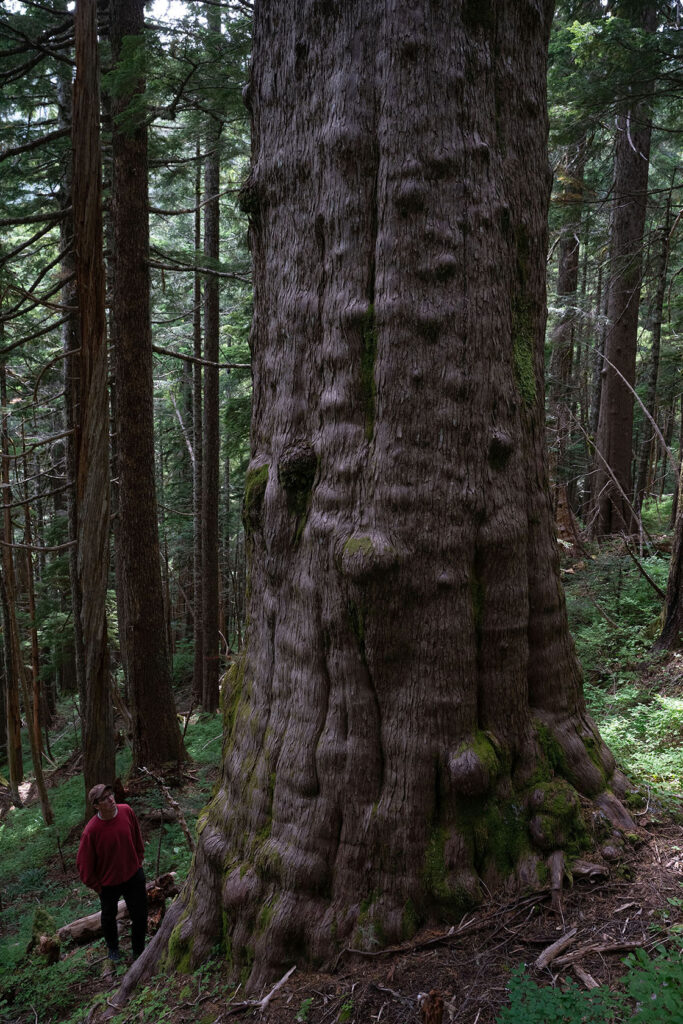
As the machinery advances towards Titania and her forest, one cannot help but think of Yeats’ rough beast, slouching, its hour come at last. But there is no at last here, in the twenty-first century, where exploiting others and the earth is held up as something to aspire towards. As Gabor Maté states, “materialistic cultures generate notions—myths, in effect—of selfish, aggressive striving and dominance as behavioural baselines, encouraging characteristics that place lesser value on connectedness to others and to Nature itself.”[7] This rough beast has been slouching far too long the Forest Defenders know, as they sit united and buoyant after their triumphant arrivals up Reid Main, vital in the fact that, as one of the Forest Defenders states: “we are going to protect something so valuable.” The keys will not be turned in the morning to continue the building of this logging road. The hour has come to put an end to these rough beasts slouching towards our Great Mother.
The Forest Defenders express how: “When you see those cut-blocks, you can hear the trees screaming, asking for our help. This last old growth is so remote industry reigns here. You get up there and you realize how real it is. You get up there and you can’t leave. Feeling the mountains and the earth. You can’t leave. We must always care for our Great Mother, Elder Bill tells us. You have to keep helping, the Forest Defenders respond. Your response is ultimately what matters. And she provides all our needs, Elder Bill reminds us. Even if you don’t win at least you’ll have tried. You will win more than if you hadn’t done anything to begin with. We are taught not to appreciate our Great Mother by the economic system, Elder Bill guides us. We’re the stop gap, planting the seed that we can actually do something. We need to defend the land because that’s what you do when the land is being destroyed. Give back. We are where we are meant to be.”
The Cookie is a landscape unto itself.
Slices of stumps from clear cuts, ‘cookies’ are both evidence and symbols and, from a technical perspective, used by Forest Defenders to block logging roads. This first cookie, a piece of another lost epic that had towered as an integral part of an old growth forest, was cut from a dried-out stump of an approximately 1400-year-old redcedar found in yet another clear cut in BC, this one on the unceded land of the Klanawa valley on Huu-ay-aht Territory. Like the land where it had once stood, the 6-inch slice was so dry and fragile it virtually crumbled as it was laboriously cut with a long-reach chainsaw from the top of the stump in the middle of a cut block into a two-tonne slab that was then heaved down a make-shift ramp and into the back of a pick-up truck. It took days. Like a puzzle reassembling truth, this soon to be symbolic barricade was lovingly put back together and mounted onto a piece of plywood so it can tell the stories of what it had been, what it became and what it has come to be now. Yes, gone is the core, the ancient heart of the tree, and the surrounding segments of what was once a whole would have gradually dried up and disappeared, too, if the Forest Defenders had not retrieved a sample of what was left to show what has been taken. Cracks are as arteries still running through the depth of the cedar slab leading to the disappeared heart of the ancient tree and the circles of the lived centuries have faded, but not quite, as the dried-up arteries can lead to the possibility of a renewed heart. The space we can fill again.
Like Titania, this slice from the top of a stump of the ancient redcedar used to be a Mother Tree as both progenitor and supporter of its eco-system. We humans, having placed ourselves in the center of our world of let’s pretend, laugh at the idea of a clear-cut being a crime scene, a site of mass murder. But it is far from anything less when all that is left are stumps, gaping upwards to what they so recently were; when what was a vibrant forest floor is now nothing but debris; when bark has been denuded of Speckled Belly Lichen that is no longer absorbing the carbon dioxide of human obliviousness and denial into their serrated elegance.[8]
In the clear-cuts, everyone left or died trying. Or were unable to even try as their world crashed around them. Peregrine Falcons, perched on top of cedar snags, surveying below through the layers of canopy, down, down, all the way to the forest floor, glistening with pine needles, mosses and decomposing plants, feeding the humus and then down further, layered and layered again with the next participant, gone, in however long it takes capitalism to decimate a designated area, hovered, for a split second, as their snags crashed with their trees. Short-tailed weasels, white-chested and sleek, jolted from their burrows, scampering in circles as all entries vanished; Red-legged frogs, black speckled and always ready to leap, couldn’t; owls, Spotted and Screech, didn’t swoop that night to scoop from the bounty below, their whistled hoots punctuating black; Rufous Hummingbirds stopped questing fairy bells the next morning, flashing their iridescent red throats—and the imperceptible coughs as all spores forced from gills landed on land that will no longer receive them.
The Klanawa Cookie was brought to the meeting at Lizard Lake with the hope they would mobilize that day. And so, because of the community acting on urgency that afternoon of August 9th, 2021, the two-tonne slice of stump was hauled up Reid Main in the back of a pick-up, the truck’s gears grinding and wheels spinning up the treacherous slope over and through recently blasted granite and big rocks that sometimes had to be removed by hand before the truck could push on. Determination dug in. Once at the top of the ridge, it took four men to heave the cookie out of the back of the truck to be erected across the logging road in the middle of the night, ready for industry to arrive early Monday morning and find a slab of resistance between themselves and their machinery. Twelve feet wide and nine feet tall, the first Cookie blocked the building of the logging road headed for Titania and the watershed. Standing as a biopsy, a diagnostic study from a once living body, the slice from the stump of an ancient redcedar is evidence of what has been done and the resistance that has arisen because of it. The struggle to save the old growth is a focus for people in their care for the forest, says Elder Bill. They’re drawn to the forest because they feel a sense of wholeness with what we are all a part of. Forest Defenders put back together what has been lost so that they can save what will be if they don’t do anything about it. All life is our service to the forest, to our Great Mother, Elder Bill states.
What must they have looked like, faces glowing around the campfire that first night of the Fairy Creek Blockades? They said: we came, we’re here, we’re going to do it. We don’t know what will happen, but we’ll do it again and again.

On the morning of August 10th, 2020,
after fitful sleeps in tents or their cars surrounded by the machinery, they sit in front of the first Cookie blocking industry from climbing into the machinery and allowing the rock drills to blast, the excavators to scrape, the rock trucks to be filled, the birds to jolt and circle, displaced, no longer knowing where it is safe land, the startled cutting of their wings in the air silenced beneath the snorts of the machinery headed towards Titania. That is the plan that still hasn’t happened.
“You wake up early and sit in the dark at 3 a.m. Who knows what’s going to come out of the darkness. The unknown of the whole situation was really intense because you don’t know if people are going to be angry. You’re vulnerable out there. You’re putting yourself in harm’s way. You really just want to go home,” one of the first Forest Defenders re-calls as another remembers:
“4 am. Waiting for industry. It’s cold as anything in the morning, even in the summer. We hung the first banners on the machinery. On the rock drills. Stop Teal Jones! No Roads Into Fairy Creek! We’re all waiting for industry. We’re all nervous. We’re sitting there. We’re talking about what to do. If they, you know, if they’ll get aggressive.”
5 a.m. The sun starts to crest the mountain, casting sharp lines across the rock drill, exposing its sinews of cables, striating the resting arm of the excavator with long shadows from the trees, bringing the machinery to life. The robins begin their morning song on cue, as always, their bright notes proclaiming the new day, as they have done since long before the idea of taking the trees has cursed these shores. But their bright song is hollow today in the company of these intruders, a melody straining for what it’s supposed to be in the presence of what doesn’t belong here.
The metal brutes, hunching as mercenaries for industry, are backgrounded by striations of salmon pink and the lush purple of Oregon grape as the sun reacquaints itself with the tops of the mountains. It is a beautiful sunrise. Still carrying the night’s cold that caused the ocean mist to bunch up in the watershed, clouds extend as far as the ocean. The line of the horizon is barely discernible as the edges of ocean and sky merge. The Forest Defenders look down at a cloud forest where mountains are islands, an ecosystem vibrant with salty droplets.
“We all have something in common,” a Forest Defender explains. “We all wanted to protect the forest and we’re all breathing the beautiful air. We’re all in awe of just being up there in the fresh air. The quiet. Even though we could still see clearcuts, the sunrise was magical.”
A pair of ravens begin their daily surveillance of the treetops as night moves towards the brilliant blue of a high mountain sky. As though in comradery with the Forest Defenders, these tricksters have decided to yell today and they fly in sporadic swoops, the urgency of their calls tearing through the chill in counterpoint with the robins’ attempts at uncompromised joy. One raven is lifted by an updraft, shoots up, spins, rolls in the current, dives and spirals with the pull of the downdraft: the other follows. Wing-tips flash purple outrage. Their gleaming black bodies cut through the air as though they are transforming creation. The logging road snakes.
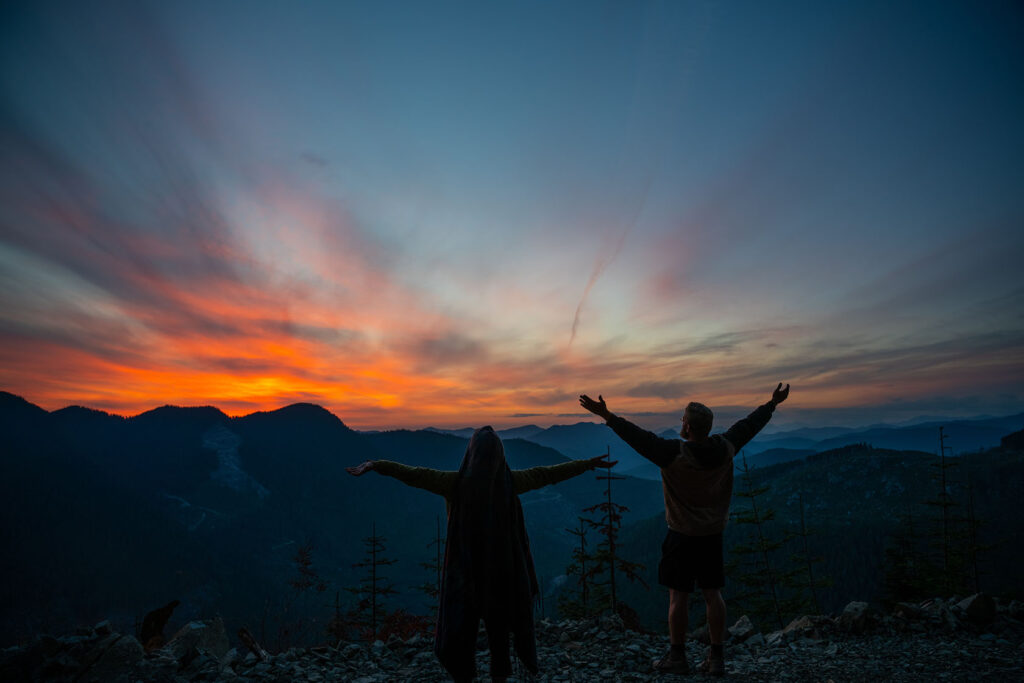
“There was a lot of tension. Everybody was tense,”
a Forest Defender re-calls the first morning. “Everybody was nervous and we didn’t know if the police were going to show up right away, were we going to get arrested, were we going to get criminal records, were loggers going to be pissed and come in a group and attack us. It was, yeah, it was that tense. Putting yourself in harm’s way, and it’s just kind of like this really intense homesickness, the combination of being out on a logging road deep in the woods and in the middle of some logging operation and then knowing that something’s coming to get you.”
But nothing really happened. At least what one would expect when twelve people have been sitting in the dark for a couple of hours, blocking industry in a culture that protects its extraction economy at all costs, twelve people sitting in the dark with no idea of what was going to happen, fearing the worst. No conflict. No antagonism. No hatred. But this was just the beginning. No one knew about the Fairy Creek Blockades yet. It was only a matter of months until the movement to save some of the world’s last remaining ancient forest grew from twelve to thousands from across Canada, the US and as far away as Nepal and industry and police brutality and land defender resistance would escalate to a culturally transformative pitch.
After sitting on the logging road and listening and wondering what was going to come out of the darkness, what was going to come up the logging road that was becoming increasingly delineated as the rising sun intensified the suspense:
“We hear a truck, one truck, coming slowly up the mountain. And we’re all talking to get over being silent or else we’re talking together to make each other comfortable because we were all nervous as hell.”
“The plan was to stay sitting down so that we wouldn’t be intimidating, not that we were, but of course we didn’t want to be. We didn’t want to do anything that would get anybody angry.”
“The truck came up in the dark and idled. I think he was just like what the fuck because we were way up on this ridge like nobody expected anybody to be there let alone twelve people and so he just idled for a few minutes, and it was really tense and then he backed away. He just backed out of there and drove back down the hill. We saw the headlights go.”
7 a.m. approaches and the mid-summer sun has begun to warm the forest floor and the blasted granite of the logging roads. The wind has increased from the Pacific to push up over the mountains, and the up and downdrafts have intensified, increasing the speed of the ravens’ soars and spins. For the Forest Defenders, still sitting in front of the Cookie, the salt-filled wind has intensified in tandem with the alleviation of the darkness, but not the apprehension of what is going to happen next. Of course, they will return. More of them next time. And the same tension carries on for another couple of hours.
“The unknown of the whole situation was really intense. We’re all talking to get over being silent. We were all nervous as hell. You don’t know if people are going to be angry. We’re talking together to make each other comfortable.”
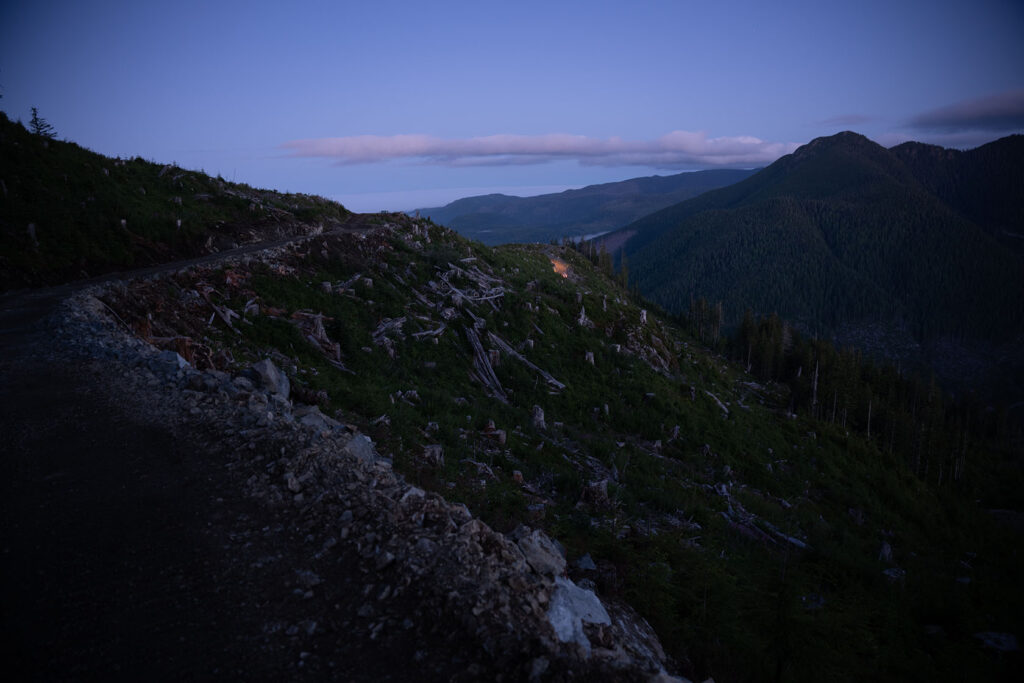
“A few hours later three trucks arrived one by one around the last curve. One guy got out. Just one guy whose name was Sean. Sean was the first guy, and he was the machine operator who was supposed to be blasting that day and he had gone back to call into work to say hey, there’s these fucking people and they said, oh go back up and just see if you can make sure that the machinery is, okay. So, he hopped out. He wanted to check his machine and we were trying to be silent.”
“The other guys got out and we offered them coffee. I can’t remember if they took any. I know none of them sat down. It was silent at first. We kept sitting. They were standing. I think they were a bit nervous too because we outnumbered them.”
“Why are you here?”
a roadbuilder asks, breaking the silence, his curiosity sincere, never expecting to find twelve people blocking his way to work that morning.
“Look at Google Earth. Have you seen Google Earth?” a Forest Defender responds in earnest, grateful for the question, wanting to inform and connect. “There’s not much left. The Fairy Creek Watershed. It’s one piece. One green patch and nowhere else is like that.”
“We have to work, though. This is our job, how we support our families,” the roadbuilder speaks his truth.
“Yeah, I get it. We just want to save some old growth forest for our kids.” The Forest Defender speaks his. Silence, the ravens swirling overhead. Then: the Forest Defender looks directly into the man’s eyes, “can you do me a favor, please?”
“Yeah sure.” Gazes connect.
“When you go home, go on Google Earth and look up Fairy Creek and look at all of the watershed. Then slowly, slowly zoom out until you have all of Vancouver Island on your monitor. Can you do that for me?”
“Oh sure. That’s no problem. I’d love to do that.”
“Yeah, and once you do that, you’ll understand exactly why we’re here.”[9]
*
“At first, both the groups were so tense,”
another Forest Defender remembers, “but once there was a friendly conversation, it just broke that down right away and everyone relaxed.”
“Could you take a picture of us, please? I asked Sean. And he was like, oh, I don’t know if my boss would approve of that, and I laughed and I said don’t worry. We won’t rat you out. We won’t tell him.”
“And then Sean took a picture of us in front of the first Cookie.”
When they met Sean, it was the beginning of the Forest Defenders, industry, and the RCMP being on a first name basis. However, over the months that followed, the first name basis transformed from paradoxically amicable to a source of awareness and strategy in what became guerilla warfare without the gunfire. When the implementation of the Teal Jones logging corporation’s exclusion zone made peaceful protest illegal in Canada eight months later, the RCMP’s Community Industry Response Group (C-IRG)—or private mercenaries for industry—was brought in to police the protests against multi-million-dollar resource projects under the guise of keeping the community, ironically including the Forest Defenders, safe[10]—such paternalistic proclamations of keeping the peace and protecting the community really an excuse to brutalize the people fighting to keep old growth forests and all that has resided there for millennia safe. Known to the Forest Defenders as the Green Guys, the Commanding Officers of C-IRG also became known by their first names. The Forest Defenders knew what level of aggression to expect that week based on who was in charge and, with that familiarity, how hard they had to work to block the logging roads and vigilant they had to be to protect themselves and each other. Some commanding officers were more lenient, a bit more tolerant, maybe even questioned the actions they had been instructed to follow. Others, not so much. Nothing is ever black and white in human interaction, even during a protest to end the black and white ideology of no compromise when it comes to exploiting Indigenous peoples and their land. And, in the beginning, before a duplicitous militia was brought in by the corporation-serving Canadian government, there was still what humanity should be.
“For months, it was just Sean we were blocking,” a Forest Defender laughs. “The guy responsible for the blasting. A nice guy, just doing his job, with friendly chit-chat before he drove back down the logging road again. We made a sign that said: “Block Sean.”
*
“The next day, industry came back to get their machinery in a bigger group and took photos of our licence plates.” Forest Defenders remember.
“They drove an excavator, rock drill and a rock truck all out of there.”
“The excavators went chomp, chomp, chomp down the hill.” And so industry was swallowed up by the ocean of clouds. And were gone. Just like that. For now.
“Did the trees have this planned?”
“After they left, we just sat there. We didn’t know if what we’d done had any impact. We just sat there wondering if we’d done anything that was going to make any big deal.”
“I was kind of numb like is this really happening or are we actually going to have this forest protected?”
But the forest, which has been clenching the burden of its steadily encroaching decimation, softens. The ravens slow, gliding back into their morning play; the robins’ songs are brightened by the infinite possibilities for renewal. The clouds continue to stretch along the endless edge of the ocean, obliviating the horizon, what is coming next. Some of the clear-cuts are still covered by the clouds, scars concealed, their momentary cancellation a gift during the celebration of this small triumph on the brink of its unforeseeable escalation.
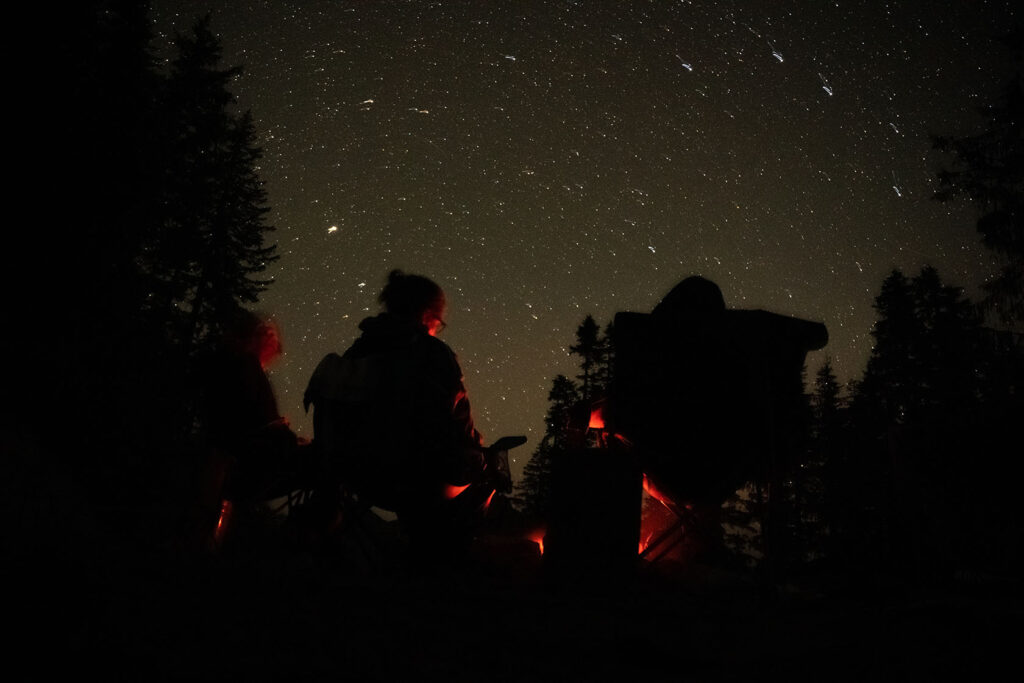
What must they have looked like that night, awash in an ocean of stars, the inky black of a high mountain sky inscribed by an infinity of meteors shooting through earth’s atmosphere even though, down below in our enclosures, we can’t see them? What must they have looked like outlined by the glow of the campfire, surrounded by silhouettes of trees, sharing homemade spaghetti made from dehydrated garden-tomatoes, forest mushrooms, the food packed that morning because of a feeling they would go up and block the logging road right away. A cello vitalizes the hope that maybe we’re going to protect the forest, maybe even industry realizes the value of this for our future generations, maybe the men understood the value, too?
“We were so happy, bubbling, we were going to protect something so valuable.”[11] The community had begun, with all its pending challenges, flaws, and beauty. As Indigenous Forest Defender Rainbow Eyes says three years later: “the Fairy Creek Blockades is what we now live to recreate.”[12]
Later that first week, as Forest Defenders entrenched themselves on the line where they had stopped the road building with tents, an outhouse, a makeshift kitchen, fire pit, suspended tarps as shelter for always imminent west coast rain, Elder Bill came up to what became Ridge Camp, the first blockade camp at Fairy Creek. He came to welcome them and give formal permission to help protect his ancestral, unceded territory and the old growth forest. They sat in a circle, the first circle, on camping chairs and logs that were collateral damage by the roadbuilding and listened to the wisdom and teachings of Elder Bill that would become a regular event at the blockades as he became their spirit guide. Settler Forest Defenders explained how:
“One of the most important things I learned from Elder Bill was how to listen. Just sitting there listening to him was a big lesson. We learned how to listen to our Elders, the knowledge keepers.”
No treaties have ever been signed with the Pacheedaht First Nation. In the late 19th Century, the British crown took the land from the Indigenous peoples to build what became the colonial country called Canada, like it was the most logical thing to do, and now leases it out to logging corporations like Teal Jones and Timber West. To them, this land is just T46; to the Ancestral Indigenous peoples and the Forest Defenders, it is, in Elder Bill’s words, where we become persons.
When remembering the day he visited Ridge Camp on August 13th, 2020, Elder Bill expressed:
I was very affected when I went up to Ridge Camp for the first time. The broken rock up there is the biggest hurt to our Great Mother. It’s like stabbing her when you drill holes into her and blow it up and big chunks of granite come down. I felt numb, achy, kind of cold from my bottom up, from my feet up and I was in a cold sweat. And I now realize looking back: it was the broken rock of the granite mountain that was blown up and left there ruthlessly, shivering.
*
To be continued…
This is an excerpt from the beginning of our in-progress book with the working title, Flying the Coop: The Fairy Creek Blockades & the Legacy of Pacheedaht Elder Bill Jones. Here is the description of the full book for your interest:
“Flying the Coop will inspire personal transformation through reacquainting ourselves with our Great Mother and rediscovering our original Aboriginal selves.
This book is a work of narrative nonfiction, interviews, and research. It is the life story of residential school survivor and spiritual leader, Elder Bill Jones, and an intimate account of the Fairy Creek Blockades and its cultural and transformative effects.
The Fairy Creek Blockades, a fight to save some of the world’s last remaining old growth, became the largest act of civil disobedience in Canadian history. As forest defenders risked their safety and people travelled from as far as Nepal to show their support, between five and seven thousand people were, in Elder Bill Jones’ words, “re-indigenized”—including himself.
This book weaves together the story of Elder Bill Jones’ personal decolonization with the story of the blockades, the place where, after a lifetime of being beaten down by the colonized consciousness that continues to hold First Nations captive, he had the epiphany: “I know what happened!” At Fairy Creek, both settler and Indigenous Forest Defenders became reacquainted with our Great Mother. As Elder Bill states: “We are the Great Mother’s care-persons as she is our care-being. We are here to be guided by and protect her.”
Beginning with the first night of the blockade on August 9th, 2020, the narrative then reaches back to the early 1890s and the stories told to Elder Bill as a child by his grandfather, Charlie Jones. Beginning with the plagues and the implementation of the Indian Act, the narrative travels through Elder Bill’s personal life and family history, his residential school experiences, his coercion into destroying his ancestral land and working as a logger, an intimate narrative of the community at the Fairy Creek Blockades with all of its triumphs and chaos, to the lawsuit against forest defenders by the logging corporation Teal Jones—including Elder Bill as their spiritual leader—and exposing the challenges facing Canadian Truth & Reconciliation. Memoir, legacy and prescriptive non-fiction, the book ends in ongoing triumph as Elder Bill proclaims: “We will show the world that we are going in peace and happiness knowing that we are the winners!”
Flying the Coop is not only a memoir and an investigation into the complexities of the Indian Act and the relationships between Indigenous peoples and settlers in Canada, but also a work of literature. Our goal is to create a compelling narrative so that the reader won’t be able to put the book down even when they are confronting very difficult—yet essential—issues from under-represented voices and under-acknowledged history and current events. As such, this book is a combination of original literary fiction and non-fiction that weaves together interviews, poetic prose, and Elder Bill’s teachings with the ultimate goal of instilling personal and cultural transformation in the reader and society at large.”
Elder Bill Jones and Karen Moe (July 2024)
If you’d like to learn more
about the book and consider supporting the writing and publishing process, check out our GoFundMe page. In the updates of the GoFundMe page, you can also watch a presentation about the book by Elder Bill and Karen Moe hosted by Joshua Wright where Elder Bill and Karen talk about the process and progress of the book and Karen gives a reading.
https://www.gofundme.com/f/support-pacheedaht-elder-bill-jones-legacy
*
You can learn about author and activist Karen Moe by visiting her website:
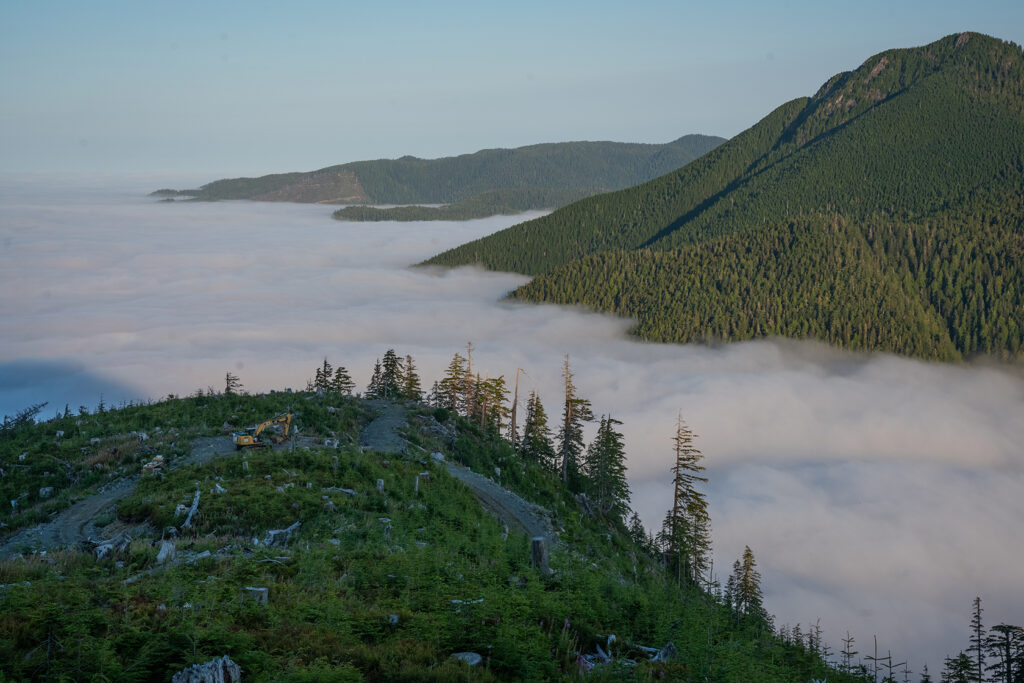
Notes:
[1] Suzanne Simard Finding the Mother Tree: Discovering the Wisdom of the Forest Toronto: Allen Lane, 2021:8.
[2] https://www.natureunited.ca/what-we-do/our-priorities/innovating-for-climate-change/forest-carbon-boreal-forest/#:~:text=On%20average%2C%20global%20forests%20that,cars%20emit%20in%20one%20year
[3] https://www.climate.gov/news-features/understanding-climate/climate-change-atmospheric-carbon-dioxide; https://www.climate.gov/news-features/climate-qa/are-humans-causing-or-contributing-global-warming#:~:text=A%20net%205%20billion%20metric,atmosphere%20by%20nearly%2050%20percent.
[4] James Craig, Mike McCullich, Harlan Wright x “A Reconnaissance of Fish Habitat Restoration Opportunities in the San Juan River Watershed (1999)”. B.C Conservation Foundation, Nanaimo BC: 1; 12-13.
[5] The quotes are taken from interviews with forest defenders. Because of the current lawsuit against central Forest Defenders in the Fairy Creek Blockade, I have decided to maintain their anonymity at this time.
[6] Without a core or a crocs-section (Heaven forbid!) my guesstimate is anywhere between 800 and 2 ,000. Let me explain. Trees on the outer West Coast were all subjected to “Dancing dwarves” – periodic major earthquakes prior to and including the 9.2 (Richter scale) of 1700 which are part of and witnessed by First Nations stories.* So the average Big tree on the coast is “only 500-” it is one that survived our last 9.2. earthquake and tsunami. Dating any tree is difficult because it depends on orientation, slope and hydrology (how much water it is receiving and what forces it has to resist to survive.) Titania is in a water receiving downslope area, so she has to put out roots outwards to counter tipping down the slope and counterbalance her height. Hence she has to have a broad base. So my take is that she is a survivor from 1700 likely 800+ years old -but we could have surprises. [I tends to be conservative in my estimates.] Email correspondence with Loys Maingon MA, PhD, MSc (RPBio) November 23rd, 2023. *I asked Elder Bill about stories of the ‘dancing dwarves’ and he told me that these are some of the stories that have been lost in his culture due to the plagues and residential school erasure of their culture through the decimation of their personhood.
[7] Gabor Maté, MD, with Daniel Maté. The Myth of Normal: Trauma, Illness & Healing in a Toxic Culture. Toronto: Alfred A. Knopf Canada, 2022: 122.
[8] Cryptogamic covers are responsible for about half of the naturally occurring nitrogen fixation on land and they take up as much carbon dioxide as is released yearly from biomass burning. https://phys.org/news/2012-06-algae-lichens-mosses-huge-amounts.html. By cutting down the old-growth forest, we interfere with these intricate cooling systems. This increases wildfires and climate heating. https://www.nationalobserver.com/2021/09/11/news/tiny-lichen-could-stop-teal-jones-logging-fairy-creek-old-growth. More than 400 species of plants and animals rely on BC’s old growth forests for at least part of their life cycle https://oldgrowthforestecology.org/ecological-values-of-old-growth-forests/ecological-processes-and-functions/conservation-of-biodiversity/
[9] Thank you to Steve Fisher (camp name: FunGuy) for this story. Interview May 13th, 2024.
[10] The Fifth Estate: “Whose Police? RCMO unit acts as a private security force, critics say.” https://www.youtube.com/watch?v=kQO2RIytszY
[11] Ibid.
[12] Interview November 2023.